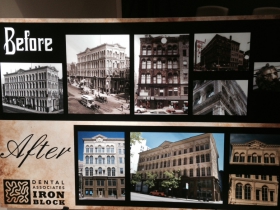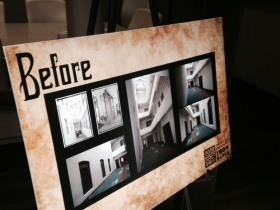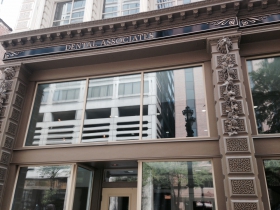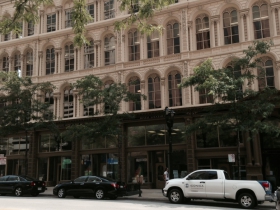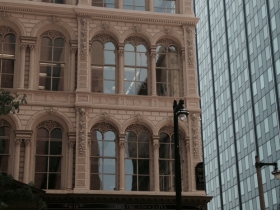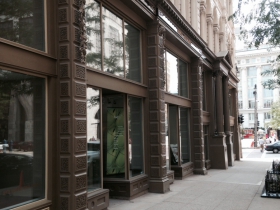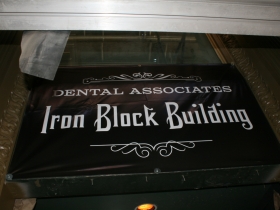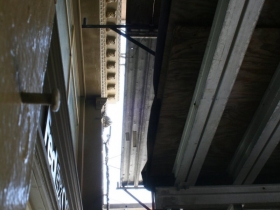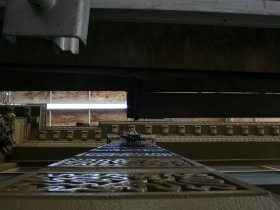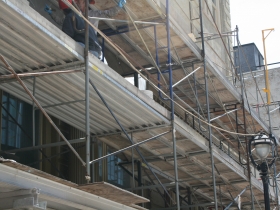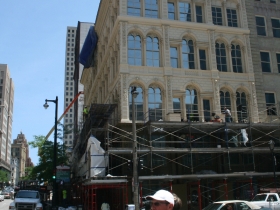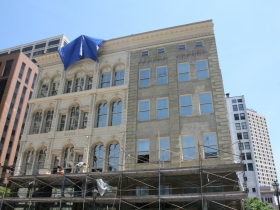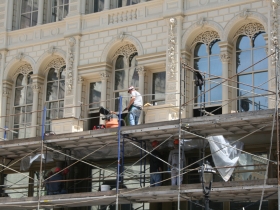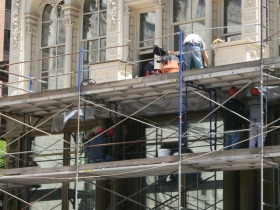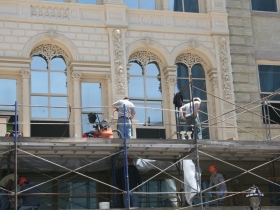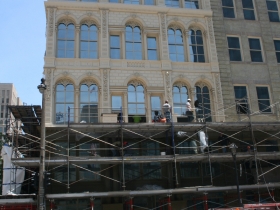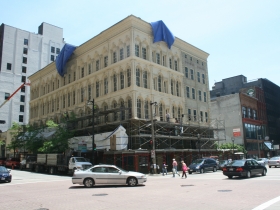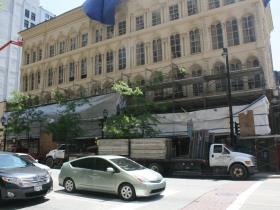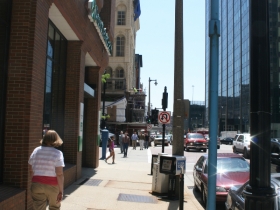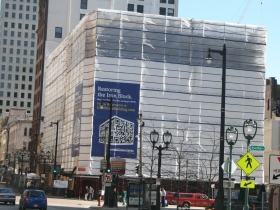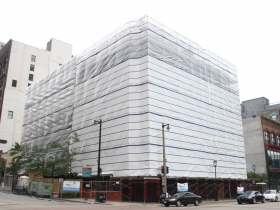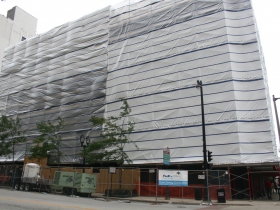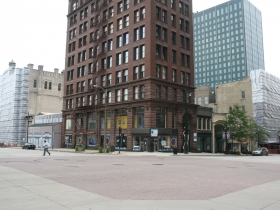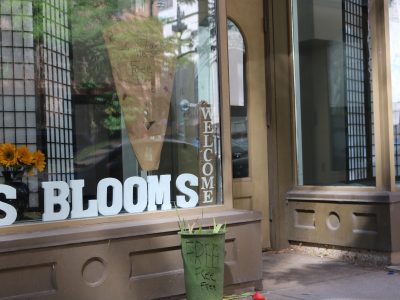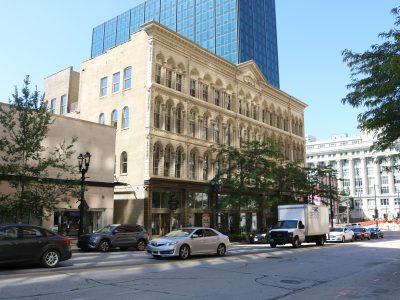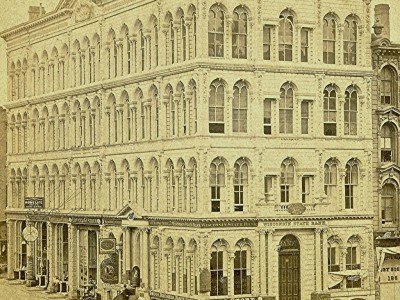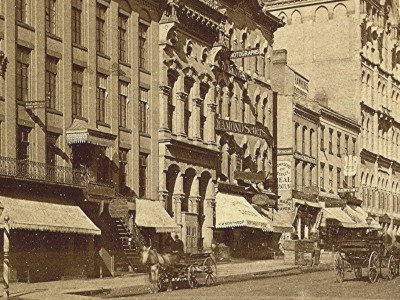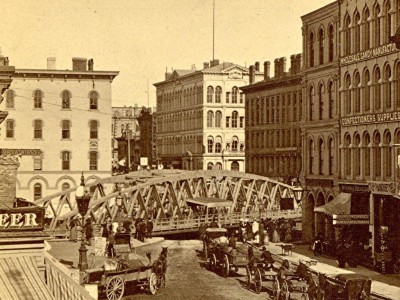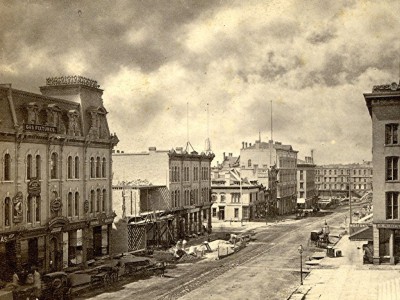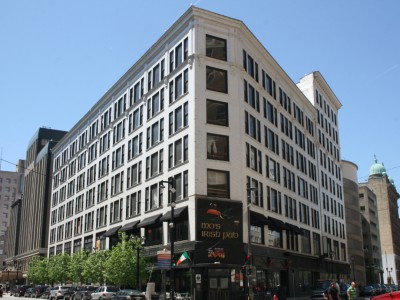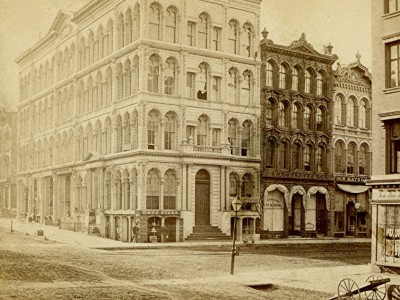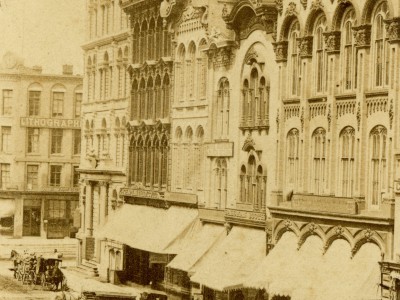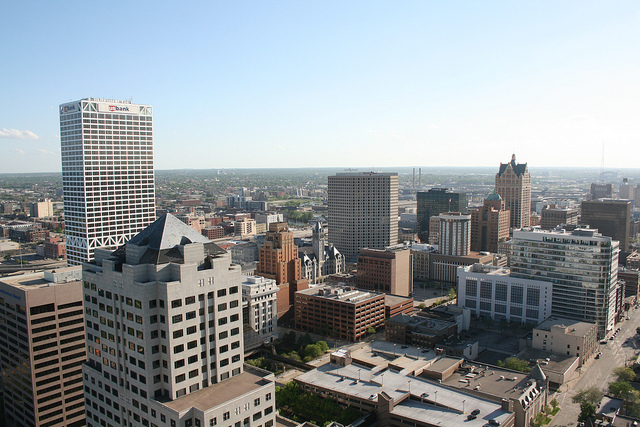Recently restored office building located at the intersection of N. Water St. and E. Wisconsin Ave. The best example of cast-iron architecture in Milwaukee.
From the 1981 Landmarks Commission/Department of City Development report…
The Iron Block ranks among Milwaukee’s most important Civil War era buildings. It is the only remaining major example of cast-iron architecture in Milwaukee and is one of a few of its kind left in the Midwest. The Iron Block was built in 1860-61 for James B. Martin, a grain dealer, real estate agent, insurance executive and banker. Originally known as the Excelsior Block or Masonic Hall (the Excelsior Masonic Lodge had its meeting rooms on the top floor) and at times referred to as Martin’s Block, the building was not widely known as the Iron Block until after 1880.
The architect was George H. Johnson, manager of the architectural department of the Daniel Badger’s Architectural Iron Works in New York City. Badger and James Bogardus were pioneers in the prefabrication of cast-iron and its used in building technology. From Badger’s company one could order by catalog a variety of pilasters, columns, window fenestrations, cornices and entablatures which could be shipped to the site, bolted together and erected. The use of cast-iron facades was widely accepted for the materials’ fireproof qualifies and economical cost. Unusual to its design is a foundation of inverted semi-circular arches of brick between the courses of stone. It was believed that foundations of this type would reinforce the walls against inward collapse and distribute the vertical load over a greater wall area.
The design of the Iron Block was influenced by the North Italian Mode of the Renaissance Revival which first appeared in the United States around 1850. It was a style of sculptural ornament which created strong contrasts using light and shadow. The cheap cast-iron technology greatly popularized the style and was commonly used in commercial architecture over the next thirty years.
When it opened, Milwaukee’s Iron Block was prestigious business address. It initially housed a bank, four stores, numerous offices, and a law library. Painted white, the structure was a striking commercial block int he heart of downtown Milwaukee.
Through the years it has significantly altered. All of the original ground floor has been removed and the cornice has been severely cut back. The interiors have been substantially remodeled. However, an elevator installed in 1879 is still in use and is believed to be the oldest one still operating in the Midwest.
From Guides to Historic Milwaukee: Juneautown Walking Tour by Mary Ellen Pagel and Virginia Palmer (1965)…
J. B. Martin asked the designer of his office building to use a new form of construction which he had admired in New York City. Johnson complied, and cast-iron units for the street facades, planned to resemble those on fashionable eastern store fronts, were shipped to Milwaukee by schooner from the Rochester (New York) Iron Works. When the building was completed, several Masonic lodges rented quarters in the upper stories, and Martin named the block Excelsior in honor of the lodge to which he belonged. But the public, fascinated by the ususual cast-iron construction, refused to call the building anything but Martin’s Iron Block. Looking at the building’s North Water Street side, one detects the location of its entrance in the days when the heaviest traffic was along this street.
Photos
Content referencing Iron Block Building
New Florist Opening Downtown
Ados Flowers is the culmination of a lifelong passion for Alando McMurtry.
Sep 1st, 2022 by Sophie BolichMidwest Shores Opening in Iron Block Building
Shop selling fossils, crystals and polished rocks is located downtown—just a stone's throw from Penzeys Spices.
Sep 1st, 2022 by Sophie Bolich42 Lounge Is Shrine to Nerd Culture
Downtown bar has lots of video and tabletop games, along with good happy hour prices.
Mar 31st, 2016 by Joey GrihalvaIron Block Building, About 1867
Influenced by the North Italian Renaissance Revival, its cast-iron architecture is rare.
Jan 20th, 2016 by Jeff BeutnerVan Cott Block Building, Late 1860s
It had many businesses and is now where the high-rise First Financial Centre is located.
Jan 5th, 2016 by Jeff BeutnerWisconsin Ave. and Northwestern Mutual, 1870s
The company's new headquarters was proof of the city's increasingly cosmopolitan style.
Nov 25th, 2015 by Jeff BeutnerWisconsin Avenue Bridge, About 1880
The wooden bridge would be replaced by a new iron one two years later. It is turned to allow boats to pass on the Milwaukee River.
Jun 23rd, 2015 by Jeff BeutnerDowntown Milwaukee, 1871
Remarkably, many of these buildings still stand today on Wisconsin Avenue.
Jun 3rd, 2015 by Jeff BeutnerWalker’s Budget Reduces Historic Tax Credits
Tighter guidelines for credits and less total funding could hurt development in Milwaukee.
Feb 20th, 2015 by Andrew McCannT. A. Chapman Late 1860s
Long before Gimbel's and Boston Store, T.A. Chapman was the city's department store. This is its first location.
Jan 28th, 2015 by Jeff BeutnerIs Iron Block the Finest Historic Restoration Ever Done?
City officials are wowed at ribbon cutting ceremony.
Jul 29th, 2014 by Mac Writt“Cream of Cream City” to be recognized at historic preservation awards ceremony
Annual preservation honors event to be held at Best Place at the Pabst
May 19th, 2014 by Ald. Bob BaumanWater Street 1858
It’s a very early photo of Milwaukee, but the Iron Block building still survives from that era.
Jan 21st, 2014 by Jeff BeutnerLabor Day Edition
Two historic buildings are completely covered as their facades are restored.
Sep 3rd, 2012 by Jeramey JanneneHerb Kohl’s Arena Commitment, The Second Downtown Strip Club, Northwestern Mutual’s New Downtown Building, and More
This week's Eyes on Milwaukee column explores Herb Kohl's commitment to a new arena, the idea of another downtown strip club, Northwestern Mutual's potential new downtown building, and a whole lot more.
May 9th, 2012 by Jeramey JanneneMark Chmura and Company Buy Building at Pabst
Pabst Brewery Originally uploaded by compujeramey Former Green Bay Packer Mark Chmura, his brother and real estate broker Matt Chmura, and, developer and son of former Milwaukee Brewer Sal Bando, Sonny Bando through their development firm BC Pabst Holdings have purchased a three-story, 28,000 square foot building at the former Pabst Brewery on the edge of the Park East neighborhood. The building previously known as Building 14 was used for Pabst research and development. Chmura and company are already lining up tenants for the office building and may open a conference center in the 1,200 square foot penthouse that has skyline views. The tenants are apparently interested in the access the building provides to traffic from Interstate 43. We at Urban Milwaukee hope someday it’ll be able to leased based on the vibrancy of the neighborhood it’s in. I was surprised to learn that not only does the sports-supported triumvirate own this building, but they also together own the Germania Building at 135 W. Wells St. and the Iron Block Building at 200 E. Wisconsin Ave in downtown Milwaukee. So much for jock stereotypes, these three appear dedicated to urban redevelopment of historic developments. I’m happy to see their on-board with the Pabst Brewery redevelopment, which is undoubtedly going to serve as a catalyst for redevelopment of the rest of the Park East neighborhood. The Small Business Times and the Journal Sentinel each have stories on the purchase. NOTE: The building purchased is pictured in the attached image. It is the short building partially cut off on the left-hand side. If you have a better image, let us know.
Nov 19th, 2007 by Jeramey JanneneBuilding data on this page, including assessment information, was last updated on April 5, 2024
See something wrong? Want to report an issue? Contact us.

